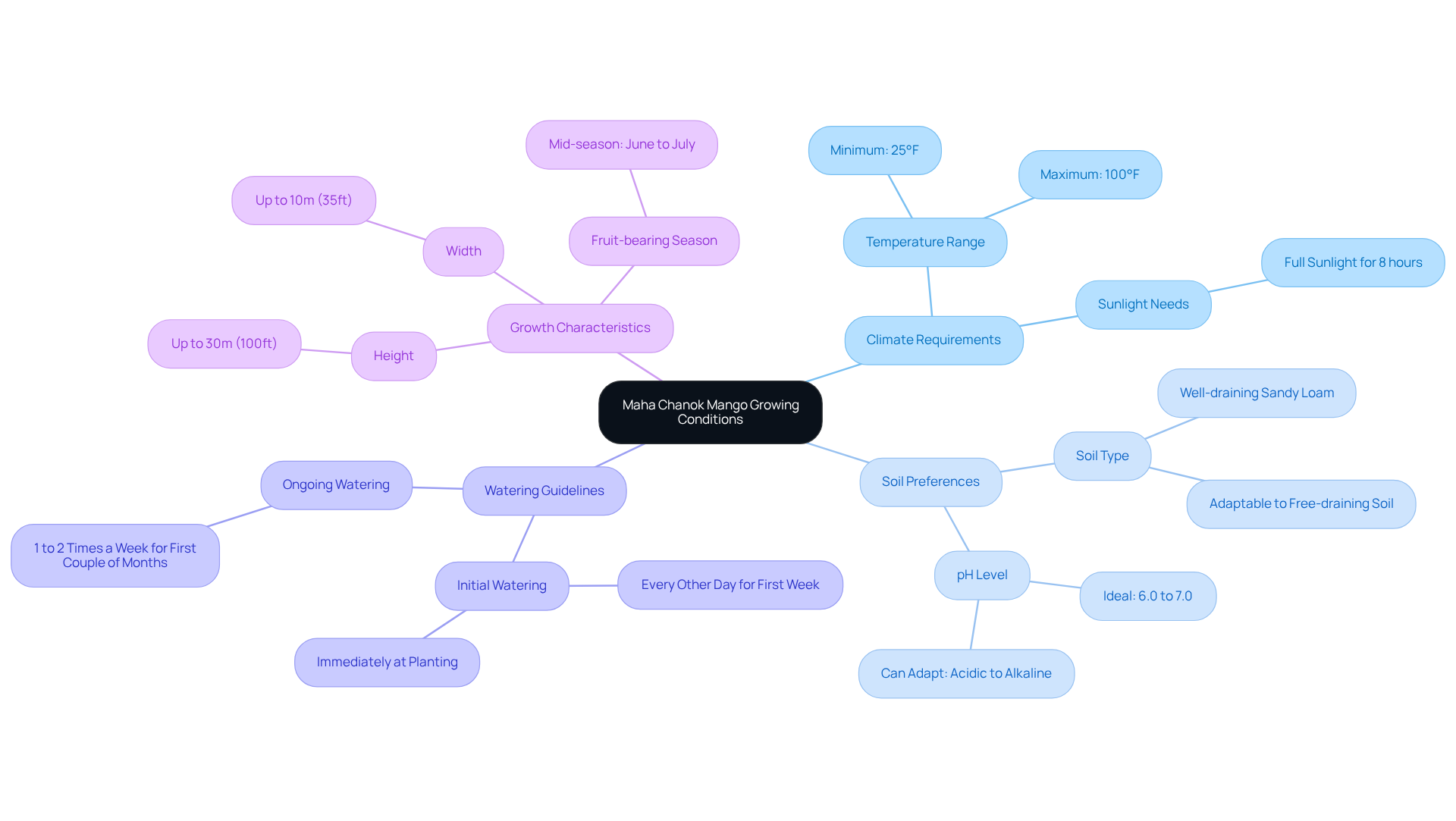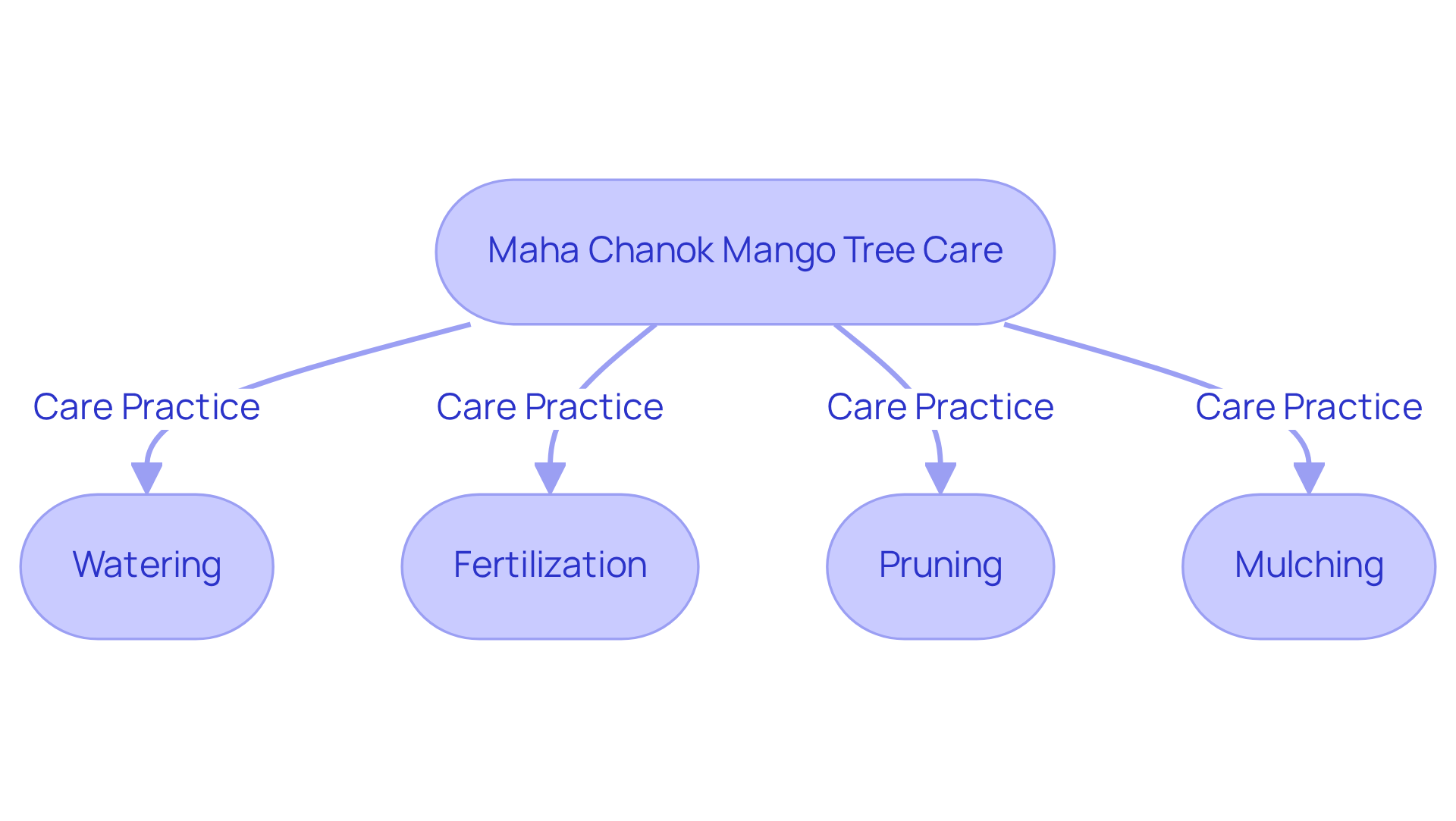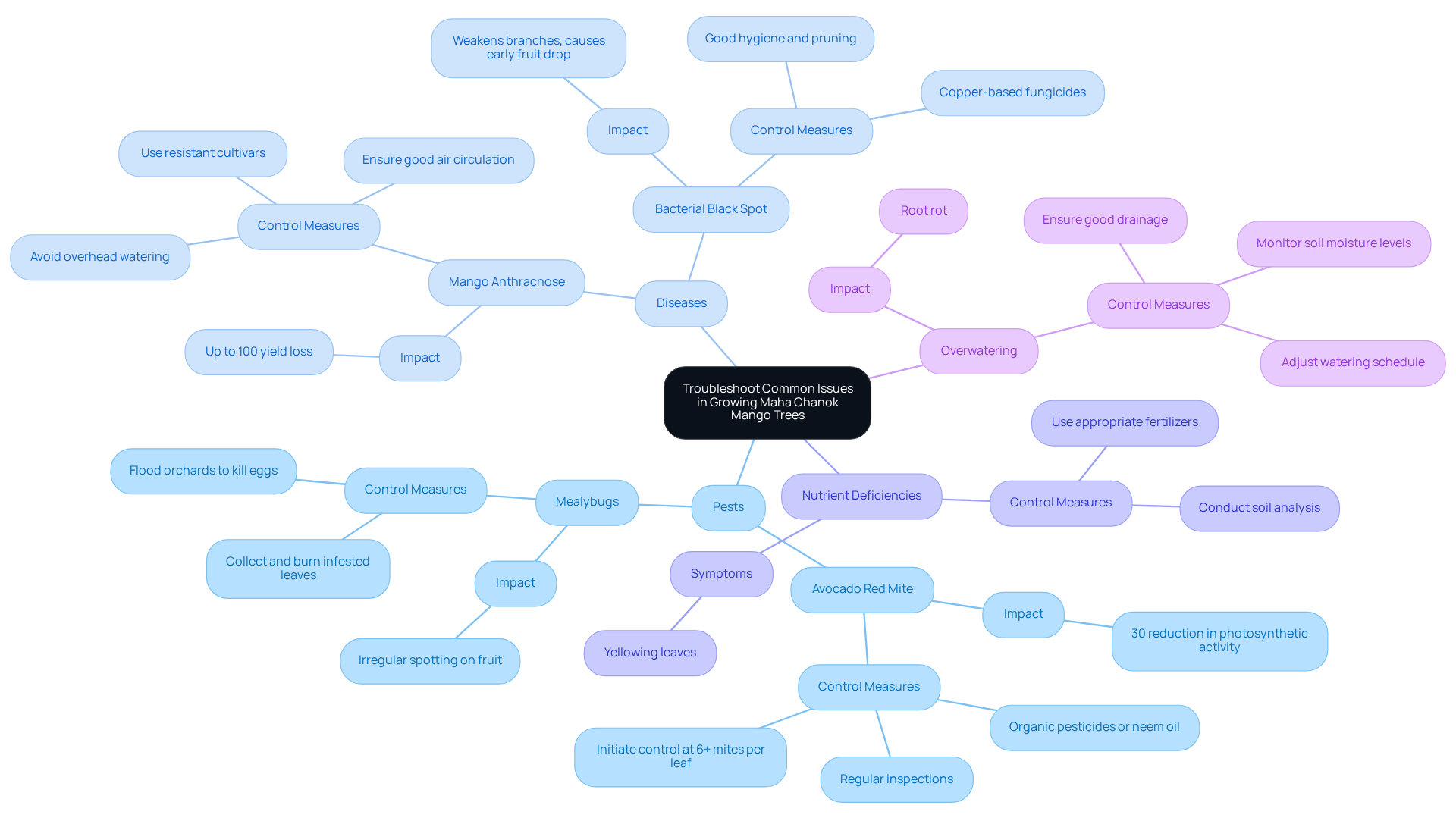
4 Steps to Successfully Grow a Maha Chanok Mango Tree
Share
Cultivating a Maha Chanok mango tree promises not only delicious, sweet fruit but also a vibrant addition to any garden. However, successful growth hinges on a keen understanding of the specific environmental needs and care practices required for this tropical fruit tree.
What occurs when these conditions are unmet, or when unforeseen challenges arise? This guide will delve into the essential steps for planting, maintaining, and troubleshooting common issues associated with Maha Chanok mango trees. By doing so, we aim to ensure that gardeners can enjoy a bountiful harvest while effectively navigating the complexities of cultivation.
🛒 Buy Maha Chanok Mango Tree for your garden at Everglades Farm
Understand the Growing Conditions for Maha Chanok Mango Trees
The maha chanok mango tree thrives in warm, tropical climates and requires full sunlight for at least 8 hours each day. These plants prefer well-draining sandy loam soil with a slightly acidic pH of 6.0 to 7.0; however, they can also adapt to free-draining soil with a pH that ranges from acidic to alkaline or neutral. It is essential to ensure that the planting area is free from standing water, as these plants are susceptible to root rot. Additionally, they can endure temperatures between 25°F and 100°F, which allows them to adapt to various climates.
Maha Chanok fruit-bearing plants can grow up to 30m (100ft) in height and 10m (35ft) in width, making it vital to consider their spatial requirements when planting. Newly planted saplings should be watered immediately at planting and then every other day for the first week. Following this, watering should occur 1 to 2 times a week for the first couple of months to ensure proper establishment. For those cultivating these plants in containers, it is recommended to provide nourishment once a month during the growth period.
The maha chanok mango tree produces maha Chanok Mangos, which are classified as a mid-season variety, typically harvested from June to July, making it crucial for planning cultivation and harvesting schedules. In areas prone to flooding, planting these fruit-bearing plants on mounds can enhance drainage. By understanding and applying these optimal conditions, you can create an environment that allows your maha chanok mango tree to flourish and produce delicious fruit.

Plant the Maha Chanok Mango Tree Properly
To successfully plant your Maha Chanok mango tree, follow these essential steps:
- Choose the Right Location: Select a spot that receives full sunlight and has good drainage, as mango plants flourish in bright conditions.
- Prepare the Planting Hole: Dig a hole that is twice as wide and as deep as the root ball of the plant. This provides ample space for the roots to spread and establish.
- Ground Preparation: Enhance the fertility and drainage of the excavated material by mixing it with compost. For dense clay compositions, incorporating sand can greatly enhance drainage, which is essential for the well-being of the mango plant. As James Mwangi Ndiritu emphasizes, 'Careful handling during harvest and packing operations reduces the physical damage that facilitates the establishment of microorganisms,' highlighting the significance of ground preparation.
- Position the Plant: Place the plant in the center of the hole, ensuring that the top of the root ball is level with the surrounding earth. Backfill the hole with the prepared earth mixture, gently compressing it to remove air pockets that could obstruct root development.
- Watering: After planting, irrigate the plant thoroughly to help compact the earth around the roots. Keep the ground damp without waterlogging during the initial weeks to aid the plant's establishment.
By following these steps, you can enhance the success rate of planting your maha chanok mango tree, which is recognized for its exceptional sweetness and flavor. Adequate soil preparation is essential, as nutritious soil plays a crucial role in the overall development and yield of fruit-bearing plants. Furthermore, these tropical plants can yield 400-600 fruits each, making them a profitable investment for home gardeners.

Maintain and Care for Your Maha Chanok Mango Tree
To effectively maintain and care for your Maha Chanok mango tree, consider the following essential practices:
-
Watering: Water the plant deeply once a week, ensuring that the top 2 inches of soil dry out between waterings. Mature mango plants generally require 15-25 gallons of water every 7-10 days. During dry spells, increase the frequency to keep the plant adequately hydrated. Regularly check soil moisture levels to prevent issues related to over or underwatering.
-
Fertilization: Apply a balanced fertilizer, such as 10-10-10, every 6-8 weeks during the growing season. Newly planted mango plants should not be fertilized until they are established, typically in the fall and spring. This fertilization schedule delivers vital nutrients that promote strong growth and enhance crop production.
-
Pruning: Lightly trim the plant annually to remove dead or diseased branches and shape the canopy. This practice encourages healthy growth and improves air circulation, which is vital for preventing diseases and promoting fruit set. Appropriate pruning methods can significantly enhance the health and productivity of the plant.
-
Mulching: Apply a layer of organic material around the base of the plant to retain moisture, suppress weeds, and improve soil health over time. A 2-4 inch layer of mulch helps regulate soil temperature and reduces evaporation, contributing to the overall vitality of your mango tree.

Troubleshoot Common Issues in Growing Maha Chanok Mango Trees
Cultivating the maha chanok mango tree can present various challenges; however, with appropriate strategies, you can ensure a healthy and productive yield. This section outlines common issues and effective solutions to address them:
-
Pests: Vigilance against pests such as aphids, mealybugs, and scale insects is crucial. These pests can significantly impact plant health and fruit quality, with the avocado red mite potentially causing a decline of up to 30% in photosynthetic activity of leaves. To mitigate this risk, employ organic pesticides or neem oil as preventive measures, and conduct regular inspections of leaves and stems for early signs of infestation. Control measures should be initiated when pest populations reach concerning levels, specifically when there are six or more mites per leaf, to prevent damage.
-
Diseases: Fungal infections, particularly mango anthracnose, pose a substantial threat to mango plants, leading to yield losses of up to 100% if not managed effectively. To reduce this risk, ensure good air circulation around the tree and avoid overhead watering, which can create a humid environment conducive to fungal growth. Implementing proper cultural practices and utilizing resistant cultivars can further enhance disease management. Additionally, be aware of Bacterial Black Spot disease, which can weaken branches and result in early fruit drop.
-
Nutrient Deficiencies: Yellowing leaves may indicate nutrient shortages, which can hinder growth and yield. Conduct a soil analysis to assess nutrient levels and amend the soil with appropriate fertilizers designed for fruit plants. Regular fertilization can bolster plant vigor and improve overall health.
-
Overwatering: Overwatering is a frequent mistake that can lead to root rot, a serious condition for mango trees. Ensure that the ground drains well and adjust your watering schedule according to weather conditions. Monitoring soil moisture levels will help maintain the right balance, promoting healthy root development.
By proactively addressing these challenges, you can cultivate thriving Maha Chanok mango trees that produce delicious fruit, enhancing your gardening experience.

Conclusion
Successfully cultivating a Maha Chanok mango tree necessitates a thorough understanding of its unique growth requirements and care practices. By ensuring optimal conditions—such as proper sunlight, well-draining soil, and adequate space for growth—the foundation for a fruitful harvest is firmly established. The outlined steps for planting, maintaining, and troubleshooting common issues underscore the importance of attentive care to achieve a thriving mango tree.
Key insights include the necessity of:
- Regular watering
- Appropriate fertilization
- Vigilant pest management
Each of these elements plays a crucial role in promoting healthy growth and maximizing fruit production. Additionally, addressing challenges such as nutrient deficiencies and diseases can significantly enhance the overall health and yield of the tree.
In essence, nurturing a Maha Chanok mango tree involves not only planting but also ongoing care and proactive management. Embracing these practices can lead to a bountiful harvest, transforming your gardening endeavor into a rewarding experience. For those passionate about horticulture, the journey of growing this exceptional mango variety presents both challenges and the sweet rewards of delicious fruit.
Grow Your Own Maha Chanok Mango Tree Today!
Start now with Everglades Farm and enjoy the sweet rewards of your gardening efforts.
🥭 Buy Maha Chanok Mango Tree
🥭 Explore Mango Trees Collection
Frequently Asked Questions
What climate is best for growing Maha Chanok mango trees?
Maha Chanok mango trees thrive in warm, tropical climates and require full sunlight for at least 8 hours each day.
What type of soil do Maha Chanok mango trees prefer?
They prefer well-draining sandy loam soil with a slightly acidic pH of 6.0 to 7.0, but can adapt to free-draining soil with a pH that ranges from acidic to alkaline or neutral.
What temperature range can Maha Chanok mango trees endure?
These trees can endure temperatures between 25°F and 100°F, allowing them to adapt to various climates.
How tall and wide can Maha Chanok mango trees grow?
Maha Chanok mango trees can grow up to 30m (100ft) in height and 10m (35ft) in width.
How should newly planted Maha Chanok mango saplings be cared for?
Newly planted saplings should be watered immediately at planting and then every other day for the first week. After that, watering should occur 1 to 2 times a week for the first couple of months.
How often should container-grown Maha Chanok mango trees be nourished?
Container-grown Maha Chanok mango trees should be nourished once a month during the growth period.
When are Maha Chanok mangos typically harvested?
Maha Chanok mangos are classified as a mid-season variety and are typically harvested from June to July.
What should be done in areas prone to flooding when planting Maha Chanok mango trees?
In areas prone to flooding, it is recommended to plant these fruit-bearing plants on mounds to enhance drainage.


